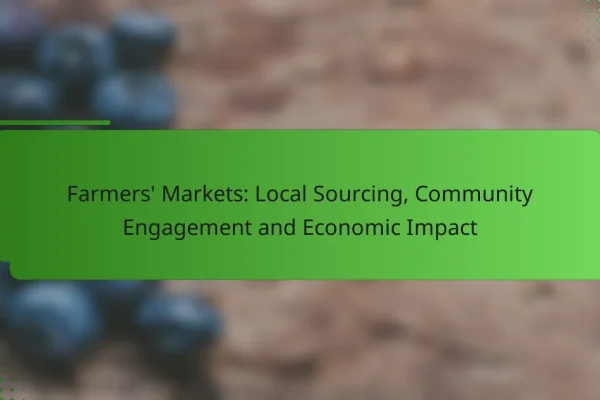How does local sourcing benefit slow food initiatives?
Local sourcing significantly enhances slow food initiatives by fostering community engagement and promoting sustainable practices. It connects consumers with local producers, ensuring fresher ingredients while supporting regional economies.
Supports local economies
Local sourcing directly stimulates local economies by keeping money within the community. When consumers purchase food from nearby farms or markets, they contribute to the livelihoods of local farmers and businesses, which can lead to job creation and economic stability.
Supporting local economies also encourages the development of small-scale farms and businesses, which often prioritize quality over quantity. This can result in a more diverse food landscape and reduce reliance on large, industrial food systems.
Reduces carbon footprint
By sourcing food locally, the carbon footprint associated with transportation is significantly reduced. Food that travels shorter distances requires less fuel and energy, which contributes to lower greenhouse gas emissions.
Additionally, local sourcing often means that food is harvested at peak ripeness, which can further decrease the need for refrigeration and long-term storage, both of which consume energy. This practice aligns with sustainable living goals and helps combat climate change.
Enhances food freshness
Local sourcing enhances food freshness by allowing consumers to access produce that is picked at its peak. Foods that travel shorter distances are less likely to lose flavor and nutritional value, providing a superior eating experience.
For example, fruits and vegetables from local farms can often be consumed within hours of harvest, compared to those shipped from distant locations that may take days or weeks to reach the consumer. This immediacy not only improves taste but also supports better health outcomes.
Promotes biodiversity
Local sourcing promotes biodiversity by encouraging the cultivation of a wider variety of crops and livestock. Small, local farms often grow heirloom varieties and unique species that are not typically found in large-scale agricultural operations.
This diversity can lead to more resilient ecosystems and a richer food culture. By supporting local farmers who prioritize biodiversity, consumers help preserve traditional farming practices and protect endangered species.
Strengthens community ties
Local sourcing strengthens community ties by fostering relationships between consumers and producers. Farmers’ markets, local food events, and community-supported agriculture (CSA) programs create opportunities for people to connect and engage with their food sources.
These interactions build trust and transparency in the food system, encouraging consumers to support local initiatives. As communities come together around food, they often develop a shared identity and commitment to sustainable practices.
What are the best practices for local sourcing?
Best practices for local sourcing involve building strong connections with nearby producers, actively engaging in community markets, and planning menus around seasonal ingredients. These strategies not only enhance the freshness of food offerings but also support local economies and reduce environmental impact.
Establish relationships with local farmers
Building relationships with local farmers is essential for effective local sourcing. Start by visiting farms and engaging in conversations to understand their practices and product availability. Regular communication can lead to better pricing and quality assurance.
Consider forming partnerships that allow for consistent supply, such as subscription models or pre-ordering systems. This not only secures fresh produce but also fosters a sense of community and trust.
Participate in farmers’ markets
Farmers’ markets are excellent venues for sourcing local ingredients directly from producers. By participating, you can meet various vendors, sample products, and negotiate prices. This face-to-face interaction often leads to better deals and unique offerings.
Regular visits to farmers’ markets also help you stay informed about seasonal produce, allowing you to adjust your menu accordingly. Look for markets that operate year-round for a consistent supply of local goods.
Utilize local food cooperatives
Local food cooperatives can be a valuable resource for sourcing ingredients in bulk at competitive prices. These cooperatives often focus on organic and sustainably produced items, aligning with the slow food philosophy.
Joining a cooperative can provide access to a wider variety of products while supporting local farmers. Additionally, many cooperatives offer educational resources and networking opportunities that can enhance your sourcing strategies.
Implement seasonal menu planning
Seasonal menu planning is crucial for maximizing the benefits of local sourcing. By designing menus that highlight ingredients at their peak freshness, you can enhance flavor and reduce costs. This approach also encourages creativity in the kitchen.
To implement seasonal planning, keep a calendar of local harvests and adjust your offerings accordingly. This not only attracts customers looking for fresh dishes but also minimizes waste by using ingredients when they are most abundant.
Which local sourcing platforms are recommended?
Several local sourcing platforms can help connect consumers with nearby farms and food producers. These platforms facilitate access to fresh, locally sourced food, making it easier to support local economies and sustainable practices.
Farmigo
Farmigo is a platform that connects consumers directly with local farms, allowing users to order fresh produce and other products online. Customers can choose from a variety of items, which are then delivered to convenient pickup locations or directly to their homes.
When using Farmigo, consider the seasonal availability of products, as offerings may vary throughout the year. This platform is particularly beneficial for those looking to incorporate more organic and locally grown foods into their diets.
LocalHarvest
LocalHarvest is a comprehensive directory of small farms and farmers’ markets across the United States. Users can search for local produce, meats, and dairy products, as well as find community-supported agriculture (CSA) programs.
This platform emphasizes transparency, providing information on farming practices and product availability. LocalHarvest is ideal for consumers who prioritize knowing the sources of their food and supporting sustainable agriculture.
Eatwell Guide
The Eatwell Guide is a resource that helps consumers find local, sustainable food options in the UK. It features a variety of food producers, including farms, markets, and shops that adhere to ethical sourcing practices.
By using the Eatwell Guide, individuals can make informed choices that align with their values regarding health and sustainability. This platform is particularly useful for those seeking to reduce their carbon footprint while enjoying fresh, local foods.
Community Supported Agriculture (CSA)
Community Supported Agriculture (CSA) programs allow consumers to buy shares in a farm’s harvest, providing upfront financial support to farmers in exchange for regular deliveries of fresh produce. This model fosters a direct relationship between consumers and producers.
Participating in a CSA can enhance your connection to local agriculture and ensure you receive seasonal produce. However, it’s important to research different CSAs to find one that aligns with your preferences regarding product variety and pick-up options.
What challenges exist in local sourcing?
Local sourcing presents several challenges that can impact the availability and cost of products. These challenges include limited product availability, higher costs compared to mass-produced items, and seasonal fluctuations in supply.
Limited availability of certain products
Local sourcing often means that not all desired products are available year-round. Some items may only be produced in specific regions or during certain times of the year, limiting options for consumers and businesses alike. For example, tropical fruits may not be sourced locally in temperate climates.
To navigate this challenge, consider focusing on products that are naturally suited to your local environment. Engaging with local farmers and producers can also provide insights into what is available and when, allowing for better planning and menu development.
Higher costs compared to mass-produced items
Products sourced locally can be more expensive than their mass-produced counterparts due to smaller scale production and higher labor costs. This price difference can deter some consumers and businesses from fully committing to local sourcing. For instance, organic vegetables from a local farm may cost significantly more than those from a large supermarket chain.
To mitigate these costs, consider forming buying groups with other local businesses or consumers to increase purchasing power. Additionally, highlighting the quality and freshness of local products can justify the higher price to consumers who value sustainability.
Seasonal fluctuations
Seasonal fluctuations can greatly affect the availability of local products. Certain foods may only be in season for a few months, leading to periods of scarcity. For example, fresh berries are typically available only in summer, while root vegetables are more abundant in winter.
To adapt to these fluctuations, plan menus and product offerings around seasonal availability. Using a seasonal calendar can help in anticipating changes and making informed purchasing decisions. Additionally, consider preserving seasonal products through canning or freezing to extend their availability throughout the year.
How can e-commerce support local sourcing?
E-commerce can significantly enhance local sourcing by connecting consumers directly with local producers, making it easier to purchase fresh, regional products. This approach not only supports local economies but also reduces the carbon footprint associated with long-distance transportation.
Online marketplaces for local products
Online marketplaces serve as platforms where local farmers and artisans can showcase their products to a broader audience. Websites like Etsy or local-specific platforms allow consumers to browse and purchase goods directly from producers, ensuring that a larger share of the money stays within the community.
When using these marketplaces, consider factors such as shipping costs and delivery times, as they can vary significantly. Look for platforms that prioritize local sellers to maximize the benefits of supporting your community.
Direct-to-consumer delivery options
Direct-to-consumer delivery options enable local producers to sell their goods straight to customers, often through their own websites or apps. This model allows for fresher products and often better pricing, as it eliminates middlemen.
When choosing direct delivery services, check if they offer subscription models or one-time purchases, and consider the delivery areas they cover. Many local farms now provide weekly or bi-weekly delivery options, which can be a convenient way to receive fresh produce regularly.
Subscription services for local goods
Subscription services for local goods provide consumers with a curated selection of products delivered regularly, often featuring seasonal items. These services can include boxes of fresh produce, meats, or artisanal goods, allowing consumers to discover new products while supporting local businesses.
When selecting a subscription service, evaluate the variety of products offered, the frequency of delivery, and the total cost. Many services allow customization based on dietary preferences, ensuring that you receive items that suit your tastes while benefiting local suppliers.




